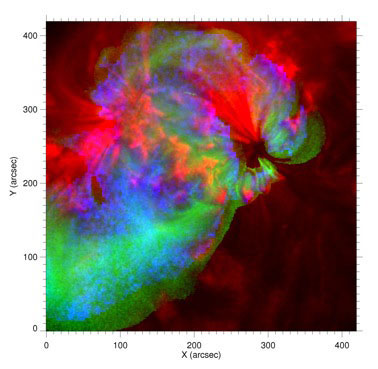Why Sun's Atmosphere Is 'So Darned Hot'

Small, sudden bursts of heat and energy, called nanoflares, areresponsible for the million-degree temperature of the sun?s tenuous atmosphere,a new study reveals.
The mystery of why temperatures in the sun's outer atmosphere,or corona, soar to several million degrees Kelvin (K) ? much hotter thantemperatures nearer the sun'ssurface ? has puzzled scientists for decades.
"Why is the sun's corona so darned hot?" saidstudy member James Klimchuk of NASA's Goddard Space Flight Center in Greenbelt, Md.
To answer this question, Klimchuk and colleagues constructeda theoretical model of the nanoflares, which are components of the loops of hotgas that arch high above the solar surface to make up the corona.
"Coronal loops are the fundamental building blocks ofthe corona," Klilmchuk said. "Their shape is defined by the magneticfield, which guides the hot flowing gases called plasma."
These loops are made up of bundles of smaller, individualmagnetic tubes or strands that can have temperatures reaching several milliondegrees Kelvin (K), even though the sun's surface is only 5,700 degrees K(9,800 Fahrenheit). (One million degrees K would be about 1.8 million degreesFahrenheit.)
Nanoflares are small, sudden bursts of energy that happenwithin these thin magnetic tubes in the corona.
Get the Space.com Newsletter
Breaking space news, the latest updates on rocket launches, skywatching events and more!
Unlike the bigger solarflares, which can be viewed through satellites and ground-based telescopesand can disrupt electronics and communications networks on Earth, nanoflaresare so small that they cannot be resolved individually, so until now, no directevidence of nanoflares was seen. Only see the combined effect of many of themoccurring at about the same time is visible.
Klimchuk's model tries to pin down exactly what happens whenthese nanoflares erupt.
"We simulate bursts of heating and predict what theloop should look like when observed with a variety of instruments,"Klimchuk said.
To test their model, the team observed gas emissions in thesolar corona using the NASA-funded X-Ray Telescope and Extreme UltravioletImaging Spectrometer on Japan's Hinodespacecraft.
"The 10 million degree temperatures we detected in thecorona can only be produced by the impulsive energy bursts," Klimchuksaid.
The ultra-hot plasma cools very quickly, however, whichexplains why it is so faint and has been so difficult to detect until now.
The energy lost from the cooling conducts down to the comparativelycooler solar surface. The gas there at the surface is heated to about 1 milliondegrees K and expands upward to become the 1 million degree component of thecorona that has been observed for many years.
Klimchuk presented the findings on August 6 at the InternationalAstronomical Union General Assembly meeting in Rio de Janeiro, Brazil.
- Video ? Hinode: Coronal Questions
- The Enduring Mysteries of the Sun
- Images: Hyperactive Sun
Join our Space Forums to keep talking space on the latest missions, night sky and more! And if you have a news tip, correction or comment, let us know at: community@space.com.

Space.com is the premier source of space exploration, innovation and astronomy news, chronicling (and celebrating) humanity's ongoing expansion across the final frontier. Originally founded in 1999, Space.com is, and always has been, the passion of writers and editors who are space fans and also trained journalists. Our current news team consists of Editor-in-Chief Tariq Malik; Editor Hanneke Weitering, Senior Space Writer Mike Wall; Senior Writer Meghan Bartels; Senior Writer Chelsea Gohd, Senior Writer Tereza Pultarova and Staff Writer Alexander Cox, focusing on e-commerce. Senior Producer Steve Spaleta oversees our space videos, with Diana Whitcroft as our Social Media Editor.









